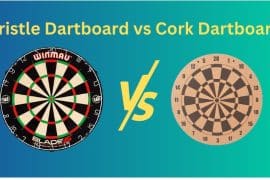Are you ready to step up your dart game and take aim at becoming a true master? Look no further than our ultimate comparison guide between bristle vs cork dart boards! Whether you’re a seasoned player or just starting, choosing the right board can make all the difference in honing your skills. Join us as we unravel the pros and cons of each type, debunk commonly held myths, and uncover which one will take your dart-throwing prowess to new heights. Get ready to embark on an exciting journey filled with thrilling matches, friendly rivalries, and unforgettable moments—all fueled by the perfect board for you. Let’s dive into this epic showdown between bristle vs cork!
History and Construction of Bristle Dart Boards
Bristle dart boards, rooted in a history dating back to the early 20th century, were initially crafted from sisal fibers, sourced from the agave plant. This natural material served as an optimal surface, allowing darts to effectively penetrate and stick. The construction process involves tightly packing and high-pressure compression of sisal fibers, creating a dense and durable playing surface that self-heals when darts are removed.
Unlike cork boards, bristle boards boast exceptional longevity, maintaining integrity and performance even with extensive use. Their thin wire spider design enhances scoring visibility, minimizing bounce-outs and providing clear target areas for fair gameplay and accurate scoring. In recent years, technological advancements have given rise to electronic dartboards that emulate traditional bristle boards while incorporating interactive features like automatic scoring and game modes.
Whether you’re a casual player seeking friendly competition or a serious competitor prioritizing precision and durability, a bristle dart board could be the perfect addition to elevate your dart-playing experience.
History and Construction of Cork Dart Boards
Cork dartboards have a centuries-old history, gaining prominence in the early 20th century as an alternative to traditional bristle boards. Constructed by tightly compressing layers of natural cork, these boards offer durability, reducing dart impact damage and minimizing bounce-outs.
Technological advancements have improved the construction process, especially with premium boards utilizing high-quality Portuguese cork known for resilience and self-healing properties. Beyond their historical significance, cork dart boards stand out for their eco-friendly nature, being made from sustainable cork harvested without harming oak trees.
For those seeking a blend of tradition and innovation in their dartboard choice, a high-quality corkboard presents a compelling option, marrying history with modern craftsmanship.
Pros and Cons of Bristle Dart Boards
Pros of Bristle Dart Boards
- Durability: Bristle dart boards are known for their exceptional durability. Constructed from tightly packed sisal fibers, they can withstand extensive gameplay without showing signs of wear and tear.
- Longevity: One of the major advantages is their longevity. With proper care, bristle dart boards can last for years, making them a reliable choice for serious players.
- Self-Healing: The ability to self-heal sets bristle boards apart. After a dart is removed, the tightly packed fibers close up, leaving no visible holes or marks on the board. This ensures a consistently smooth playing surface.
- Scoring Potential: Bristle boards offer excellent scoring potential, thanks to their thin wire spider dividers. These dividers reduce bounce-outs and provide a clear separation between scoring sections, aiding in accurate score tracking.
Cons of Bristle Dart Boards
- Cost: Bristle dart boards tend to be more expensive compared to other types, such as cork or electronic boards. The initial cost can be a deterrent for some players.
- Wear and Tear: Despite their durability, repeated heavy use can lead to wear and tear over time. Regular maintenance, such as rotating or replacing heavily used sections, may be necessary.
- Moisture Susceptibility: The sisal fibers used in bristle boards may be vulnerable to moisture damage if exposed to excessive humidity or liquid spills. Careful environmental management is required to prevent such issues.
- Sound Level: Some players may find that bristle boards produce a louder sound when darts hit the surface, which can be a consideration for those looking for a quieter gameplay experience.
In conclusion, while bristle dart boards offer durability, longevity, and self-healing properties, potential drawbacks include the higher cost, maintenance requirements, susceptibility to wear, and considerations related to moisture and sound levels. The choice depends on individual preferences and priorities.
Pros and Cons of Cork Dart Boards
Pros of Cork Dart Boards
- Affordability: Cork dart boards are generally more affordable than their bristle counterparts, making them a budget-friendly option for players.
- Quieter Gameplay: The soft nature of the cork absorbs impact noise, resulting in quieter gameplay. This can be appealing to players who prefer a more subdued gaming environment.
- Lightweight: Cork dart boards are often lighter than bristle boards, making them easier to transport and install.
Cons of Cork Dart Boards
- Durability: Cork dart boards are less durable compared to bristle boards. Over time, the surface can become compressed, and visible holes may develop where darts have landed repeatedly.
- Limited Longevity: Due to their lower durability, cork boards may have a shorter lifespan than bristle boards, especially with heavy use.
- Scoring Challenges: The softer surface of cork may result in challenges related to accurate scoring, as darts may not stick as well as they do on bristle boards.
- Aesthetics: The appearance of cork dart boards may be affected by the development of visible holes and compression over time, impacting overall aesthetics.
In summary, cork dart boards are attractive for their affordability, quiet gameplay, and lightweight design. However, they come with drawbacks such as lower durability, potential scoring challenges, and aesthetic concerns. The choice between cork and bristle boards ultimately depends on individual preferences, budget considerations, and the desired playing experience.
Which Board is Best for You?
Choosing between a bristle vs cork dart board boils down to personal preference, each offering unique qualities catering to different players. Bristle boards, common in professional competitions, feature a durable sisal fiber construction, ideal for serious players seeking longevity and self-healing properties. In contrast, cork dart boards provide a softer surface, allowing deeper dart penetration, advantageous for beginners or those desiring a less rigid feel.
Cork also dampens sound, resulting in quieter gameplay. Consider your skill level and style in the decision-making process. Experienced players aiming for professional performance may prefer bristle boards, while beginners or those favoring a softer feel might lean towards cork.
It’s important to try both types before deciding, to seek hands-on experience at local game centers or with friends who have different boards. Regardless of the choice, proper care is vital for maximizing the board’s lifespan and performance—rotate numbers regularly and store them in a cool, dry place.
In conclusion, there’s no universally “best” board; the decision hinges on individual preferences and playing styles!
How to Properly Care for Your Dart Board
Caring for your dartboard is important to ensure its longevity and preserve ideal playing conditions. Here are some effective tips on how to maintain your dartboard properly:
- Use high-quality darts with sharp points: Dull or damaged points can accelerate wear and tear on the board’s surface, leading to premature deterioration.
- Regularly rotate the dartboard: This practice evenly distributes the impact across the entire surface, preventing specific areas from wearing out faster than others.
- Protect from extreme conditions: Avoid exposing your dartboard to direct sunlight or extreme temperatures, as excessive heat or cold can warp the fibers and compromise the board’s integrity.
- Keep it clean: After each use, wipe down your dartboard with a soft cloth to remove any accumulated dirt or debris. This prevents foreign materials from becoming embedded in the surface.
- Invest in a dartboard cabinet or surround: Consider getting a high-quality dartboard cabinet or surround to shield both your walls and your dartboard from accidental damage caused by stray darts.
By following these straightforward maintenance practices, you can enjoy extended hours of satisfying gameplay while preserving the lifespan of your cherished dartboard!
Final Verdict: Bristle or Cork?
In the realm of bristle versus cork dart boards, the decision boils down to personal preferences and specific needs. Bristle boards, synonymous with professional standards, excel in durability, self-healing attributes, and superior bounce-back action—ideal for serious players prioritizing performance and longevity. Conversely, cork dart boards offer a distinct, softer playing experience marked by quietness and budget-friendliness.
Tailored for home use or noise-conscious settings, cork boards ensure extended enjoyment. For seasoned players emphasizing performance, a high-quality bristle board emerges as the optimal choice. However, those inclined towards affordability or a tranquil home gaming atmosphere may find cork dart boards better suited to their preferences.
Irrespective of the selected board type, diligent care is paramount for its longevity. Key practices include regular rotation for even wear distribution, safeguarding against moisture, and using soft-tip darts for electronic boards. Ultimately, the journey from bristle to cork concludes with the acknowledgment that the perfect dartboard aligns with individual tastes and playing environments.



